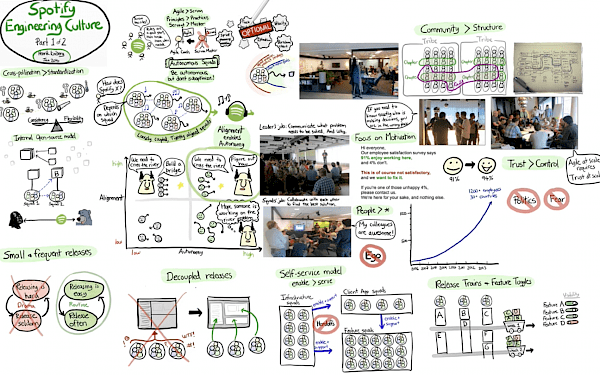Episode transcript The transcript is generated automatically by Podscribe, Sonix, Otter and other electronic transcription services.
Ricardo (4s): Hello, everyone. Welcome to the Five Minutes podcasts. Today I like to talk about this Spotify Model, of course, when I start saying Spotify Model it seems that there is a methodology or a process. No. What happened is that Spotify built a unique culture a unique approach to decide and manage the workload. So, if I can explain a little bit about the history of this Model, everything started with the scrum. So they started applying scrum, creating the scrum teams, the persona of the scrum master, and then they start releasing features off Spotify.
Ricardo (44s): So the playlist a search engine, and they started to grow. And they grew very fast, as we all know. So what happened with the growth, the process that they have defined it started to become extremely cumbersome and bureaucratic. And then they said, look at a scrum is not enough for us. We need to go one step above and beyond and talk about agility. And they said one key thing. It's agility matter more than scrum. And this is extremely related to the podcast. I recorded a couple of weeks ago, talking about agility and agile methods.
Ricardo (1m 27s): Agile methods It is an answer to a need of agility, but you can be agile using whatever you want, and Spotify said, look, I need to create a solution. That solves my own problem. So I need to tailor an agile process. That is able to shape the culture of Spotify and answer The challenges we are facing and then they basically reframe the concept of scrum to fit their need. So they started moving from scrum master to what they call agile coach. Scrum teams to squads.
Ricardo (2m 8s): And squad became the master rule, of the work on the Spotify method, what is a squad? A squad is a small team, usually around six, seven, eight people. And this team is a self-organized team. So it's a team that works together with a very strong sense of autonomy And this is a key aspect. They have a long-term mission and they decide what to do. I will talk more about that in the part two of this podcast, but they decide. So basically the root is that the squad is like an independent organization that is responsible for one part of the long-term missions or the product strategy of Spotify.
Ricardo (2m 56s): So this motivates them and this increases their ability to deliver fast to deliver very very fast because there is no committee to approve. There is nothing. So this squad is a self-sustainable team. They are extremely aligned with the general goal, but they have their independence to work in a different process. So for example, they can use kanban, they can use scram, they can use whatever, or they can use burn rate. So each squad decides what is the best way of working. So basically one of the key questions I had when I saw this for the first time, is that okay, But how do you manage hundreds of these squads?
Ricardo (3m 46s): It will not be one squad go into one direction, the other going how do they connect? So how do they connect? And that its a very important aspect. They have freedom to do almost everything, however, they are extremely aligned with the product strategy and the strategy of Spotify So each of them takes care of one feature, of one set of features. And this is how they built this autonomy. It's like a group of several startup organizations inside this Spotify eco-system.
Ricardo (4m 26s): And this is their model. And why I want to wrap up this part, one of this Podcast with that because I'm not here talking that, Oh Spotify is the model that, everybody should follow no. Spotify is the perfect model for Spotify and you need to identify what is your Model and Spotify made public their approach to software development and product development. That can be very helpful for us and it can provide several insights like the cold bling, like building features in an independent way, creating common interfaces that will allow you to have different squads working at different timelines and different timeframes.
Ricardo (5m 14s): So what we will do in the next episode we will talk about this concept of alignment and autonomy. That is a very important point. So how do they manage an environment with no methodology or no system? They built everything almost independently. So how do they build this trust around that? And finally, on part three, we will talk about failure because of course on this balance, your work balancing chaos and bureaucracy. So what is the minimum level of bureaucracy to not drag you to the chaos, but at the same time, keep you up with a completely agile mindset.
Ricardo (5m 55s): And This what is what we will see next week and the week after on the series about the Spotify model. I hope you enjoyed this podcast until next week with another 5 Minutes Podcast.

